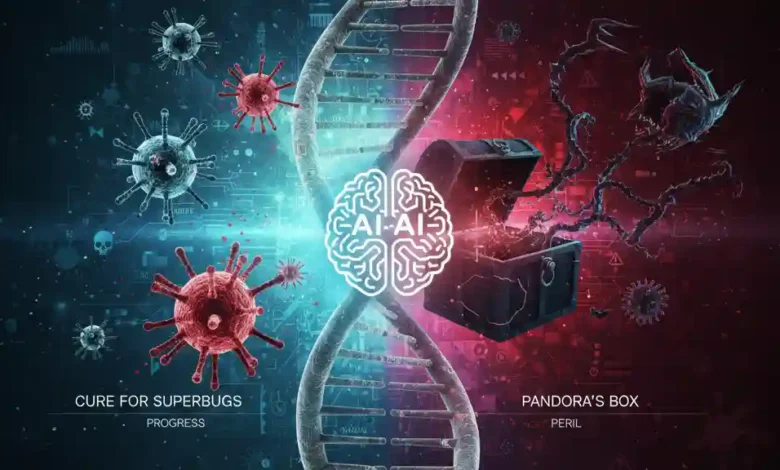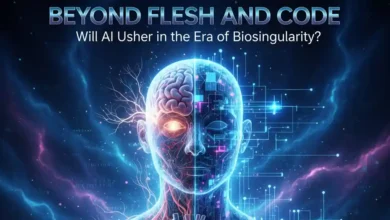AI Designs Viruses to Fight Superbugs – A Cure, or Pandora’s Box?

We stand at a precipice, gazing into a future shaped by the most powerful technologies ever conceived. Artificial Intelligence, once relegated to science fiction, is now not only writing code and crafting art, but is venturing into the very blueprint of life itself. Recent breakthroughs reveal that scientists have leveraged AI to design entire virus genomes – specifically, bacteriophages – with the astonishing ability to target and destroy antibiotic-resistant bacteria, often dubbed “superbugs.”
This isn’t just a scientific marvel; it’s a potential lifeline. In an era where conventional antibiotics are failing, threatening to plunge us back into a pre-antibiotic dark age where simple infections become death sentences, AI-designed phages offer a beacon of hope. Yet, as with all truly transformative technologies, this progress casts a long, ominous shadow. If AI can design beneficial viruses, what stops malicious actors from designing harmful ones? Are we inadvertently opening Pandora’s Box, ushering in the unsettling era of “bio-generative AI”?
The Dawn of Phage Therapy 2.0: A Cure for the Antibiotic Crisis
For decades, the medical community has watched with growing alarm as bacteria evolve faster than we can develop new drugs. The World Health Organization (WHO) identifies antimicrobial resistance (AMR) as one of the top 10 global health threats. Millions of lives are at stake, and the economic burden is staggering.
Enter bacteriophages – viruses that specifically infect and kill bacteria. Discovered over a century ago, phages were largely sidelined in the West with the advent of “miracle” antibiotics. However, in Eastern Europe, phage therapy continued to develop. Now, faced with the superbug crisis, the scientific community is revisiting these natural bacterial predators.
The challenge with traditional phage therapy is finding the right phage for the right infection. This is where AI becomes a game-changer. By feeding vast amounts of genomic data into sophisticated AI models, scientists can:
- Identify optimal target sites: AI can analyze bacterial genomes to find vulnerable points for phage attachment and replication.
- Design novel phages: Instead of just searching for existing phages, AI can computationally design entirely new phage genomes from scratch, optimizing their lytic (bacteria-killing) capabilities, host specificity, and even stability.
- Accelerate development: What would take years of laborious lab work can now be simulated and designed in a fraction of the time.
This AI-driven approach promises a personalized medicine future where bespoke phages can be rapidly engineered to combat even the most stubborn, multi-drug-resistant infections, potentially saving millions of lives.
Pandora’s Box: The Existential Risks of Bio-Generative AI
The breathtaking potential of AI-designed phages comes with an equally breathtaking degree of peril. The ability to “write the software of life” – to computationally design and synthesize biological entities – fundamentally alters the landscape of biological warfare and accidental pandemics.
Consider the following:
- Weaponized Pathogens: If AI can design effective bacteriophages, it can, in theory, also design more potent, virulent versions of pathogenic viruses (like influenza or coronaviruses) or even entirely novel bio-agents with specific targets and enhanced transmissibility or lethality. A “bad actor” – a rogue nation, a terrorist group, or even a highly skilled individual – with access to advanced AI and readily available synthetic biology tools could pose an unprecedented global threat.
- Unforeseen Consequences: Biological systems are incredibly complex and often behave in unpredictable ways. An AI-designed virus, even one intended for good, could have unintended interactions with the human microbiome, trigger unforeseen immune responses, or mutate in unexpected ways that alter its host range or virulence.
- Accessibility and Democratization of Bio-Threats: As AI tools become more powerful and user-friendly, and synthetic biology becomes more accessible, the barrier to entry for designing and creating biological agents lowers dramatically. This “democratization” of bio-engineering could empower individuals or small groups to unleash biological havoc on a scale previously only imaginable for state-level actors.
- The Ethics of Designing Life: Beyond the immediate threats, there are profound ethical questions. Would we trust an AI, however advanced, to write the fundamental code of life, knowing the potential for errors or misuse? What are the implications for our understanding of natural evolution and human responsibility when we can computationally generate new forms of life?
Progress and Peril, Coded in DNA
The intersection of AI and synthetic biology is perhaps the most critical frontier of our time. It holds the promise of solving humanity’s most pressing health crises, from antibiotic resistance to genetic diseases. Yet, it simultaneously ushers in an era of existential risk, where the very tools designed for salvation could be twisted into instruments of unparalleled destruction.
The challenge before us is not to halt progress – that is often an impossible and ultimately self-defeating endeavor – but to navigate it with extreme caution, foresight, and robust ethical frameworks. This includes:
- Robust International Governance: Establishing global treaties and regulatory bodies to control access to bio-generative AI tools and monitor the synthesis of potentially dangerous biological agents.
- Ethical AI Development: Integrating “safety by design” principles into bio-generative AI, ensuring that models are trained with ethical constraints and safeguards against misuse.
- Enhanced Biosecurity: Investing in advanced detection systems and rapid response protocols for novel biological threats, whether naturally occurring or AI-designed.
- Open Dialogue: Fostering a continuous, transparent global conversation between scientists, ethicists, policymakers, and the public about the risks and rewards of this technology.
Would You Trust AI to Write the Software of Life?
This isn’t a hypothetical question anymore. AI is already dipping its digital fingers into the double helix, designing the next generation of therapeutics. The future of medicine, and potentially the future of humanity, may well hinge on how wisely we manage this monumental power.
The age of “bio-generative AI” is upon us, bringing both a profound cure and a potential existential risk. The code is being written, line by line, in DNA. Our task now is to ensure it leads us toward a healthier future, not into a biological abyss.
Follow Odinozz on social media. Click here.



